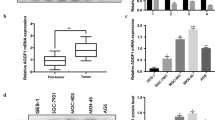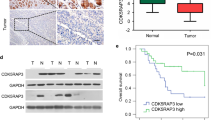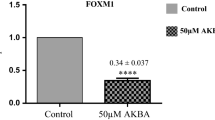Abstract
Purpose
To explore the effects and mechanisms of GSK126, a novel inhibitor of histone methyltransferase enhancer of zeste homologue 2, on cancer cell migration.
Methods
Gastric cancer cell line MGC803 and human lung adenocarcinoma cell line A549 were treated with GSK126 at three doses. Transwell and wound healing assays were conducted to detect cell migration. Human umbilical vein endothelial cells tube formation assay and chick embryo chorioallantoic membrane assay were performed to assess the effects of GSK126 on angiogenesis in vitro and in vivo, respectively. The mRNA level of VEGF-A was detected by quantitative PCR, and the protein levels of VEGF-A were detected both by western blot analysis and immunohistochemistry. Epi-fluorescent intensity was obtained by in vivo imaging.
Results
GSK126 inhibited cell migration in both MGC803 and A549 in a dose-dependent manner, as revealed by transwell and wound healing assays. The effects of GSK 126 were similar to those of gefitinib at the same doses. Moreover, GSK126 at doses of 20 and 50 µM inhibited angiogenesis both in vitro and in vivo. GSK126 reduced both the mRNA and protein expression of VEGF-A in a dose-dependent manner. Finally, in vivo imaging assay revealed that GSK126 at 200 mg/kg significantly inhibited cancer cell migration.
Conclusions
GSK126 inhibits cell migration and angiogenesis in solid tumor cell lines through down-regulation of VEGF-A expression. Thus, it may be considered as a novel anticancer drug candidate for solid tumor.






Similar content being viewed by others
References
Wang RF, Zhang LH, Shan LH, Sun WG, Chai CC, Wu HM, Ibla JC, Wang LF, Liu JR (2013) Effects of the fibroblast activation protein on the invasion and migration of gastric cancer. Exp Mol Pathol. doi:10.1016/j.yexmp.2013.10.008
Gadducci A, Lanfredini N, Sergiampietri C (2015) Antiangiogenic agents in gynecological cancer: state of art and perspectives of clinical research. Crit Rev Oncol Hematol. doi:10.1016/j.critrevonc.2015.05.009
Shen L, Cui J, Liang S, Pang Y, Liu P (2013) Update of research on the role of EZH2 in cancer progression. OncoTargets Ther 6:321–324. doi:10.2147/OTT.S42453
Tan JZ, Yan Y, Wang XX, Jiang Y, Xu HE (2014) EZH2: biology, disease, and structure-based drug discovery. Acta Pharmacol Sin 35(2):161–174. doi:10.1038/aps.2013.161
Lu H, Sun J, Wang F, Feng L, Ma Y, Shen Q, Jiang Z, Sun X, Wang X, Jin H (2013) Enhancer of zeste homolog 2 activates wnt signaling through downregulating CXXC finger protein 4. Cell Death Dis 4:e776. doi:10.1038/cddis.2013.293
Takeshima H, Wakabayashi M, Hattori N, Yamashita S, Ushijima T (2015) Identification of coexistence of DNA methylation and H3K27me3 specifically in cancer cells as a promising target for epigenetic therapy. Carcinogenesis 36(2):192–201. doi:10.1093/carcin/bgu238
McCabe MT, Ott HM, Ganji G, Korenchuk S, Thompson C, Van Aller GS, Liu Y, Graves AP, Della Pietra A, Diaz E, LaFrance LV, Mellinger M, Duquenne C, Tian X, Kruger RG, McHugh CF, Brandt M, Miller WH, Dhanak D, Verma SK, Tummino PJ, Creasy CL (2012) EZH2 inhibition as a therapeutic strategy for lymphoma with EZH2-activating mutations. Nature 492(7427):108–112. doi:10.1038/nature11606
Sato T, Kaneda A, Tsuji S, Isagawa T, Yamamoto S, Fujita T, Yamanaka R, Tanaka Y, Nukiwa T, Marquez VE, Ishikawa Y, Ichinose M, Aburatani H (2013) PRC2 overexpression and PRC2-target gene repression relating to poorer prognosis in small cell lung cancer. Sci Rep 3:1911. doi:10.1038/srep01911
Brooks PC, Montgomery AM, Cheresh DA (1999) Use of the 10-day-old chick embryo model for studying angiogenesis. Methods Mol Biol 129:257–269. doi:10.1385/1-59259-249-x:257
Cheng LL, Itahana Y, Lei ZD, Chia NY, Wu Y, Yu Y, Zhang SL, Thike AA, Pandey A, Rozen S, Voorhoeve PM, Yu Q, Tan PH, Bay BH, Itahana K, Tan P (2012) TP53 genomic status regulates sensitivity of gastric cancer cells to the histone methylation inhibitor 3-deazaneplanocin A (DZNep). Clin Cancer Res Off J Am Assoc Cancer Res 18(15):4201–4212. doi:10.1158/1078-0432.CCR-12-0036
Chen L, Zhu H, Pan Y, Tang C, Watanabe M, Ruan H, Wang Y, Wang J, Yao HY, Iguchi T, Wu X (2012) Ascorbic acid uptaken by sodium-dependent vitamin C transporter 2 induces betahCG expression through Sp1 and TFAP2A transcription factors in human choriocarcinoma cells. J Clin Endocrinol Metab 97(9):E1667–E1676. doi:10.1210/jc.2012-1753
Gong Y, Xu CY, Wang JR, Hu XH, Hong D, Ji X, Shi W, Chen HX, Wang HB, Wu XM (2014) Inhibition of phosphodiesterase 5 reduces bone mass by suppression of canonical Wnt signaling. Cell Death Dis 5:e1544. doi:10.1038/cddis.2014.510
Rojas JJ, Thorne SH (2012) Theranostic potential of oncolytic vaccinia virus. Theranostics 2(4):363–373. doi:10.7150/thno.3724
Kikuchi J, Kinoshita I, Shimizu Y, Kikuchi E, Konishi J, Oizumi S, Kaga K, Matsuno Y, Nishimura M, Dosaka-Akita H (2010) Distinctive expression of the polycomb group proteins Bmi1 polycomb ring finger oncogene and enhancer of zeste homolog 2 in nonsmall cell lung cancers and their clinical and clinicopathologic significance. Cancer 116(12):3015–3024. doi:10.1002/cncr.25128
Choi JH, Song YS, Yoon JS, Song KW, Lee YY (2010) Enhancer of zeste homolog 2 expression is associated with tumor cell proliferation and metastasis in gastric cancer. APMIS Acta Pathol Microbiol et Immunol Scand 118(3):196–202. doi:10.1111/j.1600-0463.2009.02579.x
He LJ, Cai MY, Xu GL, Li JJ, Weng ZJ, Xu DZ, Luo GY, Zhu SL, Xie D (2012) Prognostic significance of overexpression of EZH2 and H3k27me3 proteins in gastric cancer. Asian Pac J Cancer Prev APJCP 13(7):3173–3178
Huqun Ishikawa R, Zhang J, Miyazawa H, Goto Y, Shimizu Y, Hagiwara K, Koyama N (2012) Enhancer of zeste homolog 2 is a novel prognostic biomarker in nonsmall cell lung cancer. Cancer 118(6):1599–1606. doi:10.1002/cncr.26441
Tang X, Milyavsky M, Shats I, Erez N, Goldfinger N, Rotter V (2004) Activated p53 suppresses the histone methyltransferase EZH2 gene. Oncogene 23(34):5759–5769. doi:10.1038/sj.onc.1207706
Chen X, Song N, Matsumoto K, Nanashima A, Nagayasu T, Hayashi T, Ying M, Endo D, Wu Z, Koji T (2013) High expression of trimethylated histone H3 at lysine 27 predicts better prognosis in non-small cell lung cancer. Int J Oncol 43(5):1467–1480. doi:10.3892/ijo.2013.2062
Kirk JS, Schaarschuch K, Dalimov Z, Lasorsa E, Ku S, Ramakrishnan S, Hu Q, Azabdaftari G, Wang J, Pili R, Ellis L (2015) Top2a identifies and provides epigenetic rationale for novel combination therapeutic strategies for aggressive prostate cancer. Oncotarget 6(5):3136–3146
Adhikary G, Grun D, Balasubramanian S, Kerr C, Huang JM, Eckert RL (2015) Survival of skin cancer stem cells requires the Ezh2 polycomb group protein. Carcinogenesis 36(7):800–810. doi:10.1093/carcin/bgv064
Maryan N, Statkiewicz M, Mikula M, Goryca K, Paziewska A, Strzalkowska A, Dabrowska M, Bujko M, Ostrowski J (2015) Regulation of the expression of claudin 23 by the enhancer of zeste 2 polycomb group protein in colorectal cancer. Mol Med Rep 12(1):728–736. doi:10.3892/mmr.2015.3378
Bai J, Chen J, Ma M, Cai M, Xu F, Wang G, Tao K, Shuai X (2014) Inhibiting enhancer of zeste homolog 2 promotes cellular senescence in gastric cancer cells SGC-7901 by activation of p21 and p16. DNA Cell Biol 33(6):337–344. doi:10.1089/dna.2014.2340
Bracken AP, Pasini D, Capra M, Prosperini E, Colli E, Helin K (2003) EZH2 is downstream of the pRB-E2F pathway, essential for proliferation and amplified in cancer. EMBO J 22(20):5323–5335. doi:10.1093/emboj/cdg542
Tonini T, D’Andrilli G, Fucito A, Gaspa L, Bagella L (2008) Importance of Ezh2 polycomb protein in tumorigenesis process interfering with the pathway of growth suppressive key elements. J Cell Physiol 214(2):295–300. doi:10.1002/jcp.21241
Shi B, Liang J, Yang X, Wang Y, Zhao Y, Wu H, Sun L, Zhang Y, Chen Y, Li R, Zhang Y, Hong M, Shang Y (2007) Integration of estrogen and Wnt signaling circuits by the polycomb group protein EZH2 in breast cancer cells. Mol Cell Biol 27(14):5105–5119. doi:10.1128/mcb.00162-07
Geng J, Li X, Zhou Z, Wu CL, Dai M, Bai X (2015) EZH2 promotes tumor progression via regulating VEGF-A/AKT signaling in non-small cell lung cancer. Cancer Lett 359(2):275–287. doi:10.1016/j.canlet.2015.01.031
Ezhkova E, Pasolli HA, Parker JS, Stokes N, Su IH, Hannon G, Tarakhovsky A, Fuchs E (2009) Ezh2 orchestrates gene expression for the stepwise differentiation of tissue-specific stem cells. Cell 136(6):1122–1135. doi:10.1016/j.cell.2008.12.043
Tonini T, Bagella L, D’Andrilli G, Claudio PP, Giordano A (2004) Ezh2 reduces the ability of HDAC1-dependent pRb2/p130 transcriptional repression of cyclin A. Oncogene 23(28):4930–4937. doi:10.1038/sj.onc.1207608
Huang SP, Wu MS, Shun CT, Wang HP, Lin MT, Kuo ML, Lin JT (2004) Interleukin-6 increases vascular endothelial growth factor and angiogenesis in gastric carcinoma. J Biomed Sci 11(4):517–527. doi:10.1159/000077902
Ferrara N (2009) Vascular endothelial growth factor. Arterioscler Thromb Vasc Biol 29(6):789–791. doi:10.1161/atvbaha.108.179663
Eswarappa SM, Fox PL (2015) Antiangiogenic VEGF-Ax: a new participant in tumor angiogenesis. Cancer Res 75(14):2765–2769. doi:10.1158/0008-5472.can-14-3805
Acknowledgments
Research reported in this publication was supported by the Natural Science Foundation of Zhejiang Province (LY12H16005 to YPY) and the Health and Family Planning Commission of Zhejiang Province (2015 KYA148 to F Z).
Author information
Authors and Affiliations
Corresponding author
Ethics declarations
Conflict of interest
The authors declare that they have no conflict of interest.
Human and animal rights statement
All animal experiments were performed in accordance with guidelines approved by Zhejiang University Institutional Animal Care and Use Committee.
Additional information
You-Ping Yang and Ling-Hui Zeng have contributed equally to this article.
Rights and permissions
About this article
Cite this article
Chen, YT., Zhu, F., Lin, WR. et al. The novel EZH2 inhibitor, GSK126, suppresses cell migration and angiogenesis via down-regulating VEGF-A. Cancer Chemother Pharmacol 77, 757–765 (2016). https://doi.org/10.1007/s00280-016-2990-1
Received:
Accepted:
Published:
Issue Date:
DOI: https://doi.org/10.1007/s00280-016-2990-1




